 |

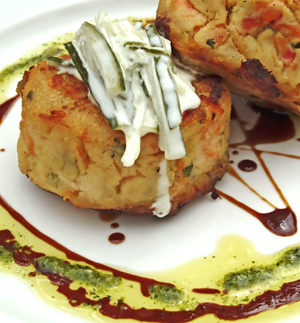 |
| Crab and potato cakes with a cucumber and yogurt dressing, pesto and aged balsamic vinegar. Photo by Guy Erwood. |
| WHAT IT IS: Acetaia Leonardi aged balsamic vinegars from Modena, Italy. In a sea of imitators and confusing “authentic balsamics,” this is the real deal. |
| WHY IT’S DIFFERENT: There’s a full line, from the most expensive tradizionales and condimentos to everyday vinegars. The condimentos taste almost as good as the tradizionales, for 60% of the cost. |
| WHY WE LOVE IT: Not every producer of great tradizionale balsamic also makes a condimento (the next level of quality) that is almost as great. We tasted these side-by-side, and were wowed by the quality of both. We’re excited by what we can better afford to enjoy on a regular basis and to give as gifts (the wonderful condimentos). |
|
|
 |

Aged To Perfection: Acetaia Leonardi Balsamic Vinegar
CAPSULE REPORT: Aged Italian balsamic vinegar can be a great experience, but most people aren’t experienced. Much of what’s on the shelf at the supermarket isn’t real balsamic, and what’s available at specialty stores is confusing. Like buying caviar, you have to know a bit before plunking down your $20.00—or your $220.00.
Everyone should experience and compare 12 and 25-year-old syrupy balsamic vinegar from a great producer of Modena, Italy—the provenance of authentic balsamic vinegar. Not for salads, these noble condiments elevate basic foods like steak, chops, seafood, and grilled vegetables to the ranks of Something Special. For dessert, a few drops with parmesan cheese, strawberries, and yes, ice cream, counts as a great gourmet experience. And Acetaia Leonardi, one of the premier producers in Modena, is ready to give it to you. Read the full review below.
- For more of our favorite oils and vinegars, click here.
- For the table of contents of the April issue of THE NIBBLE online magazine, plus the back issues archive and our most popular articles, click here.
- All of the weekly newsletters are permanently archived on TheNibble.com.
|
Balsamic Vinegar Reading List
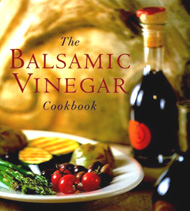 |
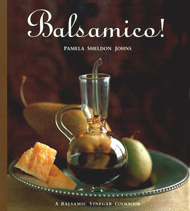 |
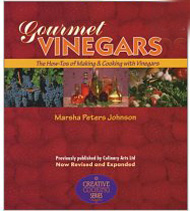 |
| The Balsamic Vinegar Cookbook, by Meesha Halm. Tantalizing recipes plus an engaging history of balsamic vinegar and how it is produced. The book also defines terms, clears up misconceptions and provides a list of mail-order sources for the best balsamic vinegars. Click here for more information. |
Balsamico: A Balsamic Vinegar Cookbook, by Pamela Sheldon Johns. Until you cook with it, you won’t know what balsamic can do to your taste buds. Excellent for ideas and recipes, with a valuable five-page history on the vinegar which will really help you to appreciate it. Click here for more information. |
Gourmet Vinegars: The How-To’s of Making and Cooking with Vinegars, by Marsha Peters Johnson. Recipes for cooking with vinegar including balsamic and for making flavored vinegars(yes, you can flavor balsamics) that are wonderful gifts as well as for your own cooking. Click here for more information. |
Aged To Perfection: Aged Balsamic Vinegars From Acetaia Leonardi
Fine balsamic is a connoisseur product, but you don’t have to be a “gourmet” to enjoy it. Its dense, sweet-tart taste is appreciated by almost everyone. Balsamic vinegar is one of the more exciting ingredients to enter the American pantry in the last 30 years. An estimated 1.75 million liters of commercial balsamic vinegar are sold each year; about 1% of that, 1,760 liters, is tradizionale (authentic) balsamic vinegar, made in the towns of Modena and Reggio Emilia, in the northern Italian region of Emilia-Romagna. Pronounced tra-DEE-tsee-oh-NAH-lay, this sable-brown liquid is the king of vinegar; it typically sells for $90 and up for just 3.5 ounces of 12-year vinegar and $150 for 25-year. If you want to approach the sacred vault of 100-year, prepare to spend $500: and yes, like drinking 1945 Chateau d’Yquem, it’s worth it to have had the experience, even once. In addition to use as a condiment, it is drunk after dinner from cordial glasses (few rare wines are as expensive ounce-per-ounce).
Our goal today is not to convince you to trade your summer vacation funds for vinegar, but to explain away the confusion surrounding balsamics, and to introduce you to a great producer of tradizionale and condimento balsamics, Acetaia Leonardi (acetaia is the word for vinegar house, analogous to winery; condimento is the next finest grade of vinegars below tradizionale; depending on the producer, the condimentos can be almost as good and 60% of the price). And, we’ll introduce the entire line, including the vinegars that are less than $40.00.
Before we present today’s products, you might like to take a few minutes to read our companion piece, Understanding Balsamic Vinegar. It will give you about as much education as you’ll ever need on the topic. We generally include this type of information in the yellow box in the middle of these reviews; but in the case of balsamic, the information merited a separate article. We’ll just begin with the summary of that article: |
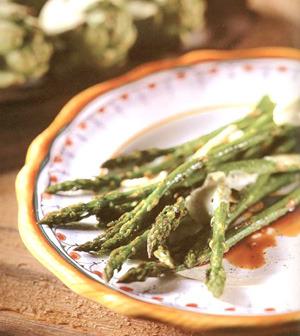 Parmesan-crusted asparagus with balsamic sauce is one of the recipes in The Balsamic Vinegar Cookbook. Parmesan-crusted asparagus with balsamic sauce is one of the recipes in The Balsamic Vinegar Cookbook.
|
There are five types of balsamic vinegars:
- Tradizionale and Condimento. Authentic balsamics made in Modena and Reggio Emilia, using artisan methods established in the Renaissance (that date back to the Middle Ages). Production of tradizionale is strictly monitored by a consortium. Condimentos are created through the same methods without going through the certification of the consortium; there is a separate consortium that monitors the quality and awards a seal to condimentos that pass its standards. These magnificent gourmet products are costly and costlier, and are used as condiments to accent foods. They also can be drunk like rare Ports, which they resemble in fruitiness and complexity. They are labeled Aceto Balsamico Tradizionale or Aceto Balsamico Condimento.
- Industriale (in-DOO-stree-AH-lay). These are mass-produced brands made in Italy using commercial processes, but still employ cooked grape must and are aged at least 3 years. Those made within the Modena and Reggio Emilia area are labeled Aceto Balsamico di Modena. The commercial balsamics from Italy (good ones can be purchased in the $15 range) are rated on a scale of 0 to 4 “leaves,” with 0 being something equivalent to cheap supermarket balsamic, “1” something a person with standards would use on a salad, “2” and “3” good for cooking and drizzling on food, and “4” a sweet, syrupy dessert vinegar.
- Imitation. Much of the commercial balsamic vinegar you’ll encounter isn’t balsamic at all, but cider vinegar that has been colored and flavored with caramel to approximate balsamic. If the bottle you’re looking at is less than $10, you can almost count on it. These can be made anywhere, range in price and quality, and are best used for salad dressing.
- Other. Some U.S. producers of fine olive oil and vinegar are also making balsamics using artisanal methods. They don’t fall into tradizionale, condimento or industriale classifications; but they are good products.
That’s the capsule; for the rest, read the article.
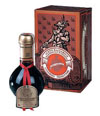 Looking For Mother’s Day Gifts? Looking For Mother’s Day Gifts?
If Mom is a gourmet, a tradizionale or condimento makes a great gift. If not, get her one of the 3- or 5- year balsamics. She’ll love the difference—and the fact that everyone will be happy to have more salads. Also can check our list of recommendations in the April issue of THE NIBBLE online magazine for some of our favorite candy, cookies, cakes and other treats.
|
We’ll now move our focus to the vinegars of Acetaia Leonardi, or the Vinegar House of Leonardi, one of the better producers among the 120 members of the Consorzio Produttori Aceto Balsamico di Modena, a tightly-regulated group that dictates how much vinegar each member can make, does blind tastings of every barrel produced and rejects half of them. Those batches that are approved are kept at the headquarters of the Consorzio and bottled by the Consorzio, so there can be no approve-and-switch. Each bottle is numbered and logged into a book. When you do buy a tradizionale, you know it’s quality (and at these prices, should be). The vinegars of Acetaia Leonardi are consistently rated outstanding within the consortium.
Acetaia Leonardi was founded in 1871 in Magreta di Formigne, a town few miles north of the city of Modena. Today it is run by Giovanni Leonardi and his son, Francesco. The family produces some of the world’s finest vinegars. The acetaia is a 19th-century building on the banks of the river Secchia, which divides Modena from Reggio Emilia. These two provinces, with eponymous cities within them, are the only two places on earth where authentic balsamic vinegar can be made.
In their acetaia, the Leonardis apply well-honed skills and secrets that have been handed down for generations, making and aging their balsamics in a well-aired attic that allows for the necessary changes in temperature. |
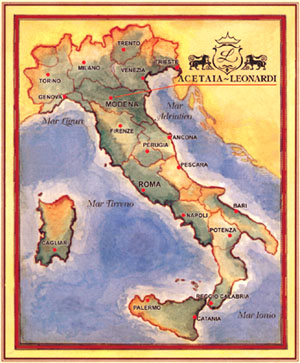
|
Great vinegar starts with superior grapes, and the Leonardis, who also make wine, cultivate the vines, choose the best grapes for the must, and supervise the cooking, acetification, and the long process of maturation and aging, where the vinegar is decanted and “topped up” in progressively smaller barrels for at least 12 years (and up to 100, although most is sold at 12 and 30 years).
No one dresses a salad with a 12-year tradizionale balsamic. Even a billionaire who could afford it (a 3.5-ounce bottle of Leonardi can costs $110 and more) wouldn’t want that kind of sweetness on his greens anymore than he’d want to drink a glass of vintage Port with a steak. There are balsamics—authentic balsamics—for every purpose. Look at balsamic vinegar the way you look at a Champagne house: you can serve 1961 Dom Perignon ($715) for your 20th anniversary, a 1990 Dom Perignon ($398) to celebrate your engagement, have Mumm’s Cordon Rouge ($36) with dinner on Saturday and pop open Mumm’s Cuvee Napa ($20) when you feel like making Champagne cocktails.
The same variety is true with balsamics: there’s an appropriate level of balsamic whether you’re looking to perk up salad or stew, put something exciting on your steak, accompany foie gras, or accent parmesan or dessert. Like a premier Champagne house, a top acetaia like Leonardi has a balsamic for every occasion.
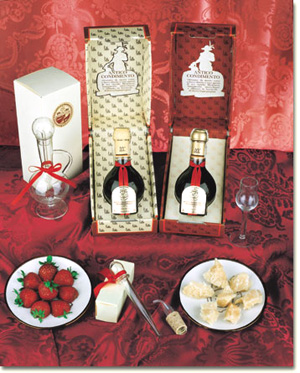
Leonardi’s tradizionale balsamics with accoutrements:
glass droppers and pour spout and a liqueur
glass, strawberries and chunks of Parmigiano-Reggiano.
Just close the door and leave us alone, thank you.
|
We recently had the opportunity to taste most of the line (short of the 50- and 100-year Il Patriarca and Il Patriarca Reserve—we’ll keep “The Patriarch” on our wish list).
The good news is that we have discovered a wonderful line of vinegars. And, as with all of our Top Picks of the Week, it is an honor just to know them.
The interesting thing about the Leonardi balsamics is not just the quality that courses through every product in the line. You don’t need to spend $100 to get to know the brand; basic balsamics can be had for $22 and $39 that will encourage you to trade way that $10 bottle you’re using. Leonardi’s “everyday” vinegars, aged for 3 and 5 years, respectively, are far better than the 12-year vinegars we have been using from other producers. They cost more, too; but we’ve given up the extra cappuccinos.
|
Even more stunning is that the quality of the condimentos at 12, 15, 20 and 30 years are strikingly close in quality to the tradizionales. The tradizionales are more dense and syrupy and tend to have longer aftertastes. But, in a blind taste test of “which is tradizionale and which is condimento,” one might guess half of them incorrectly. In wine terms, think of the tradizionale as the Proprietor’s Reserve and the condimento as the Vintner’s Reserve.
So, if you’re a vinegar-maker and are investing those many years to age your products, why not make them all tradizionale and command much higher prices?
- First, output is regulated: each member of the Consorzio Produttori Aceto Balsamico di Modena, the consortium that strictly regulates production of tradizionale balsamics, is allowed to produce only so much of it. If a producer wants to sell more (or share more) of his fine vinegar with the world, the best way to do it is by producing an incredible condimento, which has no quota. Maybe the fruit is only A instead of A+, and to cut down on labor expense, the vinegar is decanted into fewer barrels over the years. We’re just guessing, but the end result is great.
- Another way to look at making a breathtaking condimento is passion. As one industry professional expressed it, “Italians don’t look at making great food as math, but as art.”
No matter how you choose to think about these balsamics, think about when and where you are going to try them. Buy one of the cookbooks on cooking with balsamics (we’ve listed a few above), do an online search for recipes, talk to the chefs at your favorite restaurants. With outstanding tradizionales and condimentos like Leonardi’s, it’s actually quite simple: you don’t cook with them at all. You simply use them to accent foods, with pretty droplets around a plate (you can buy an official glass dropper or use a medicine dropper).
When you hear the word “dropper” and see how little is actually used, the sticker shock may be somewhat lessened:
|
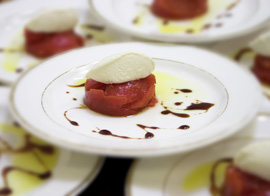
Gateau of roasted tomato and fresh mozzarella, with
extra-virgin olive oil and a drizzle of 12-year
balsamic vinegar. Photo by D.K. Gilbey.
|
- Acetaia Leonardi’s 12-year tradizionale is $109.99 (100 ml or 3.38 ounces)
- The 30-year tradizionale is $160.00
- The 100-year tradizionale is between $499.00 and $640.00†
†We show a range here not to shock but to raise an important point: prices vary widely from retailer to retailer. With the savings on the 100-year, you could almost buy a bottle of 30-year. We’ve also seen our everyday balsamic product for $16.00 to $25.00. So, it can pay to shop around.
Pricey, yes; but once you taste them, you realize you’re not in Kansas anymore, but in some land over the culinary rainbow where things are different and wondrous. These tradizionales and condimentos taste as if Port had married a great vinegar and produced offspring. They’re dense and rich—if you turn the bottle upside down, the dark liquid coats the sides like chocolate syrup. The flavors are exciting and complex.
Of course, each vinegar (tradizionale or condimento) is very different depending on what woods it has been matured in and for how long. In different bottles we found, variously, apples, cherries, plums, raisins, herbs, spices, honey, caramel, almonds and walnuts. The aromas are seductive (when was the last time that was said about vinegar?) and again remind us of old Port, with its lush fruits; plus deeper, roasted, meaty, earthy and mushroomy scents obtained from years and years of cosseting in old woods. And yes, there’s the tartness of the vinegar—a gentle tartness, the fraternal twin of the sweet, maybe the best sweet-and-sour combination on earth.
Perhaps we are getting too poetic, but that’s what these vinegars do to one. The namesake of the aforementioned Champagne, Dom Perignon, is quoted* as saying, “I see stars” when he first tasted the accidental bubbly. We would say, “We see black magic,” because when else would one ever want to sit down with a bottle of vinegar and a glass...and drink the whole thing?
*Alas, apocryphal: the story was made up by marketing people 200 years after the father’s death.
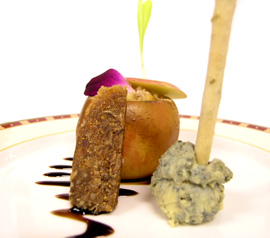
Serve drops of balsamic with plain chunks of Parmesan, or take it up a notch as shown here: a Stilton cheese “lollipop” (scoop Stilton into a ball and add a breadstick), some apple cobbler inside a scooped-out baked apple, and a fig and date bar “tower.” All beautifully complemented by 25-year balsamic vinegar.
|
We will spare you our equally poetic tasting notes, because upon reviewing them, even we can’t make a decision as to what we’d try next. Do we want more of “apple-y, plums and tangy,” or “initial explosion of many flavors but shorter finish” or “raisins and honey?” All were pretty exciting, and price tolerance and product availability will guide most people. But as you’ve heard us say many times:
- Get a group of friends together, buy them all, and conduct your own tasting. There’s no substitute for it. Ten friends can have an unforgettable evening, learn a lot, and afford the price of admission.
|
On The Menu
The “vinegar menu” at Acetaia Leonardi is extensive, and you should get to know the entire line (actually, not all is imported into the U.S., so those who travel to Italy can seek out the rest). Having spent most of this NIBBLE at the high end, we’re going to start at the affordable vinegars and work our way up. Remember, though, that everything from this producer is gold standard, even the “everyday” vinegars. Back to the wine analogy: you can taste the difference between the $25 bottle and the $5 bottle. It’s the same with vinegar—and a bottle of vinegar lasts so much longer!
Balsamic Vinegar & Saba
These authentic balsamics, made in the artisanal style but aged for shorter periods, simply can’t be compared to any factory-made balsamics. They cost more but they’re worth it. Saba is a sweetener extracted from grapes, an unusual product every cook and gourmet should get to know. Use it as a sweet dressing instead of adding a dessert sauce, honey, or whipped cream.
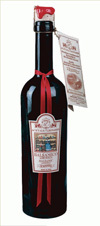 |
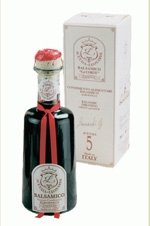 |
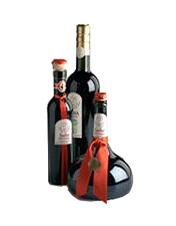 |
| 3-Year Balsamic Vinegar. Aromatic with notes of sweet wine. Deep raisin and caramel flavors. Use in salad dressings or to deglaze a pan and finish a sauce. At MarketHallFoods.com. |
5-Year Balsamic Vinegar. More of a fruity structure than the 3-year, with sweet berry and ripe grape flavors and a honey aftertaste. Pour over strawberries or warm roasted beets. At MarketHallFoods.com.
|
Saba. Aged for 4 years in chestnut and oak barrels, with a wonderful fruity character, notes of ripe grapes, sweet plums and raisins. Drizzle over cheesecake, dress a fruit salad, serve with panna cotta, use in marinades, top ice cream. At MarketHallFoods.com. |
With these balsamics, the tart flavors prevail—they haven’t been aged to syrupy sweetness like the older balsamics, or artificially sweetened like the imitation ones. They’re perfect to flavor raw and cooked vegetables, salads, sauces and meats. Some of our favorite uses:
- With mashed sweet potatoes or butternut squash: add 1 to 2 teaspoons balsamic vinegar and some freshly ground nutmeg
- As a sauce with sautéed zucchini or asparagus
- As a finishing glaze on sautéed portobello mushrooms, large shiitake mushrooms, or porcini
- In marinades
- As a dipping sauce for crudités
- As a substitute for lemon juice in homemade mayonnaise
Flavored Balsamics
These are condimento-quality balsamics that have been specially flavored.
 |
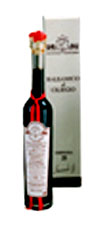 |
|
| 20-Year Juniper-Aged Balsamic Vinegar. Aged exclusively in rare juniper barrels, yielding an herbaceous, slightly spicy flavor with hints of honey. With a refined sweetness, this vinegar is perfect for savory foods: drizzle on a grilled flank steak, topped with arugula. A typical Italian use is a liberal pouring over salami or Parmigiano-Reggiano cheese. At MarketHallFoods.com. |
20-Year Cherry-Wood Balsamic Vinegar.
This special vinegar is aged solely in cherry-wood barrels, giving it a wonderfully subtle cherry flavor that lingers on the tongue. It can be used as a syrup on top of berries or ice cream, as well as a topping for panna cotta. While it is sweet, it could also be used as a sauce for a pork loin. At MarketHallFoods.com. |
|
In general, we like these flavored balsamics:
- With risottos, roast meats, fish, game, and grilled vegetables
- Sprinkled on omelets and designer pizzas, omelets
- Drizzled on ice cream
Condimentos
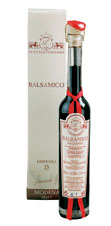 |
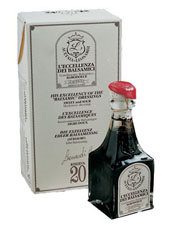 |
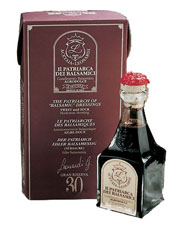 |
| 15-Year Condimento. Aromas of molasses, highly viscous, tasting of raisins and prunes. Pour over grilled flank steak or pork loin. At MarketHallFoods.com. |
20-Year Condimento.
Aromas of caramel and raisins, with a clean aftertaste. Pour over fresh berries. At Straubs.com. |
30-Year Condimento. Hints of roasted almonds, with undertones of cherry and cognac. Drizzle over roasted meats or warm porcini mushrooms. |
Take these wonderful vinegars to:
- Drizzle on your finest dishes
- Add to sparkling mineral water to make a beverage
- Drizzle over fresh strawberries, fruit salad, fruit skewers, melon halves stuffed with strawberries and mascarpone, zabaglione, chunks of parmesan cheese, plain ice cream or ice cream with strawberries
- Sprinkle on shaved white truffles topped with grated Parmigiano-Reggiano cheese; heat just until the cheese melts slightly
Tradizionales
Consorzio certified with the beige cork capsule, packaged in the trademark Giugiaro-designed bottle with the Leonardi label on one side and the Consorzio label on the other.
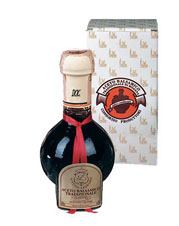 |
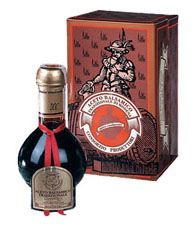 |
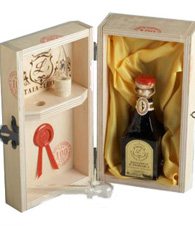 |
12-Year Tradizionale. Viscous, purple black and glistening, with notes of mint, overripe plums, heated honey. At Amazon.com.
25-Year Tradizionale Extravecchio.
100 ml, $129.99. At
Amazon.com.
|
30-Year Tradizionale.
Viscosity of maple syrup, with an opalescent radiance. Extremely aromatic, with flavor notes of sun-dried plums, dried herbs, and sweet, slightly tannic finish. |
100-Year Il Patriarca Reserve. The zenith: The only thing to do with this is to put droplets right on your tongue! Save it for foie gras or your very favorite food, where you want two of your favorite tastes in the world to meet and live happily ever after—in memory. At ShopGourmetsMarket.com. |
Use in all the ways suggested for the condimentos. And, sip it from tiny liqueur glasses as an after-dinner cordial.
The review concludes below the yellow box.
A Brief History of Balsamic Vinegar
Balsamic is different from other vinegars in that it is made from cooked must (grape juice that has not fermented). Most other vinegars are made from juice that has already been fermented into an alcoholic beverage like wine.
The first appearances of vinegar and cooked must (grape juice) date back to the third millennium B.C. in Egypt and in the Near East. Later, the Greeks and the Romans used vinegar to dress and preserve food. They made drinks by adding cooked must to water; and boiled grape must for long periods, then mixed it with honey to produce the popular sweetener, defrutum sapa.
In the Middle Ages, a well-known vinegar, laudatum acetum, was produced in Canossa, a town in the province of Reggio Emilia, and was given in a silver bottle as a present by the Marquis Bonifacio to Emperor Enrico III when, in 1046, he passed through the area en route to Rome. It is assumed, but can’t be verified, that this is the same product indicated by records that begin in the 1500’s, via the writings of the poet Ludovico Ariosto (author of Orlando Furioso and native of Reggio Emilia) at the Estensi court. “Black vinegar” was mentioned as a mix of sour vinegar and saba (sweetened vinegar) with a typical bitter-sweet flavor.
In the 16th century, when the Estensi court moved to Modena, the first evidences of the balsamic vinegar appear. Documents reveal it to have qualities that distinguish it from common vinegar and describe how to produce it, specifying that must from Trebbiano grapes must be left to mellow in an attic for several years.
For details about balsamic vinegar, read Understanding Balsamic Vinegar.
For an extensive article on the different types of vinegar, read Vinegar 101. |
If you’re in the neighborhood, you can see all stages of production yourself, and taste all these wonderful vinegars at the source. When you’re planning a trip to Italy, e-mail info@acetaialeonardi.it with dates that you’ll be in Modena. If you can’t imagine looking forward to the aromas of a vinegar factory, let us assure you—you’ll have a lot to savor.
—Karen Hochman
FORWARD THIS NIBBLE to anyone who loves fine food, needs to give a gift to a connoisseur, is planning ahead for Mother’s Day and Father’s Day, or has been longing for a great balsamic.
ACETAIA LEONARDI
Balsamic Vinegars
Products and online sources to purchase are detailed above. Click on link to return to section.
|
 |
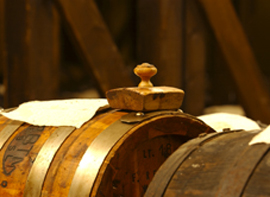
Casks (or barrels) of aging balsamic. Photo
courtesy of AcademiaBarilla.com.
|
Read about some of our other
favorite condiments and related
topics in these sections of
THE NIBBLE online magazine:
|
|
FOR ADDITIONAL INFORMATION, special offers,
contests, opinion surveys, THE NIBBLE
prior issues archive, product gift-finder and more,
visit the home page of TheNibble.com.
Do you have friends who would enjoy THE NIBBLE?
Click here to send them an invitation to sign up for their own copy.
|
ABOUT THE NIBBLE™. THE NIBBLE™, Great Food Finds™, is an online magazine plus newsletters about specialty foods and the gourmet life. It is the only consumer publication and website that focuses on reviewing the best specialty foods and beverages, in every category. The magazine also covers tabletop items, gourmet housewares, and other areas of interest to people who love fine food.
© Copyright 2004-2025 Lifestyle Direct, Inc. All rights
reserved. All information contained herein is subject to change at any time
without notice. All details must be directly confirmed with manufacturers, service
establishments and other third parties. The material in this newsletter may not
be reproduced, distributed, transmitted, cached, or otherwise used, except with
the prior written permission of Lifestyle Direct, Inc.
|
 |
|
 |










 Looking For Mother’s Day Gifts?
Looking For Mother’s Day Gifts? 














